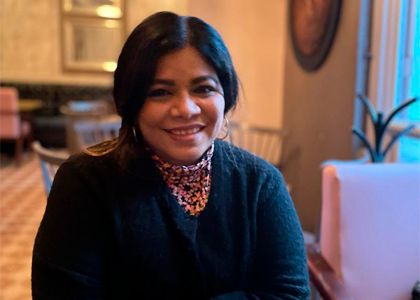Por Miriam Ramírez*
Escribo esto desde la desesperanza y el hastío, sin las respuestas correctas, ni la verdad absoluta.
La noche del 5 de enero de 2023, dos amigos culichis me contaban que el hambre no los dejaba dormir, uno rogaba por un refresco, la otra por cualquier comestible. Habían pasado todo el día encerrados, no pudieron salir ni siquiera a la tienda de la esquina, nadie lo hizo, afuera no había garantías de nada.
Ese acto tan simple de irse a dormir con hambre, me pareció devastador. A diferencia del 2019 cuando miles quedamos atrapados entre las balas, en la calle, en el trabajo, buscando refugio con extraños, esta vez quedamos atrapados en nuestros hogares, a salvo pero de nuevo atrapados.
Ese encierro, ese silencio aterrador en el que se mantuvo la ciudad el día entero, esa impotencia de saberse absolutamente desprotegido (de nuevo), hoy se ha transformado en una profunda desesperanza.
Esta vez no habrá “Culiacán Valiente”, una multitudinaria marcha a la que convocó un grupo de jóvenes en octubre de 2019 con la intención de darnos un abrazo colectivo y reafirmarnos que “somos más los buenos”.
Aquella vez la marcha fue un éxito, asistieron miles vestidos de blanco portando pancartas con frases alusivas a la paz. Hubo un festival cultural y todos nos reunimos en un parque a pintar las caritas de los niños, escuchar la música de El David Aguilar y recuperar nuestro espacio.
Luego hubo foros, conversatorios, se redactaron propuestas, se firmaron acuerdos y sin darnos cuenta llegamos al 5 de enero de 2023 y nada cambió, el mismo monstruo nos volvió a devorar.
Una de las organizadoras de aquel “Culiacán Valiente” contó que en estos días varios le han reclamado y han hecho memes burlándose de que a pesar de los esfuerzos ciudadanos, otra vez sucediera un culiacanazo. Como si fuera responsabilidad de las y los activistas evitar lo inevitable. Un disparate.
Lo que es una realidad es que hoy no hay ánimos para marchar, ni decir que somos más los buenos. Tampoco hay ánimos para defender que Sinaloa es más que la violencia. “El aguachile, la playa y la alegría de su gente”, suena a discurso gastado y chafa que solo los gobernantes y políticos se atreven a seguir repitiendo.
Para escribir este texto hablé con varios amigos y amigas culichis, artistas, activistas, periodistas, académicos, gente que lleva décadas trabajando en eso que le llaman construcción de paz. ¿Y ahora qué?, les pregunté. No me sorprendieron sus respuestas. Para resumir, diría que la mayoría se encogió de hombros con enfado.
“Me caga el término resiliencia, y ahora más”, me dijo tajante un amigo artista que ha dedicado los últimos años de su vida a acompañar a madres que buscan a sus hijos desaparecidos, ofreciéndoles técnicas de arte para canalizar el dolor.
Y es que el asunto con la resiliencia involuntaria de los culichis es que sí, aprendemos a reponernos, convivir y coexistir con el monstruo, pero también a negarlo, a esconderlo debajo de la cama y no volver a nombrarlo jamás.
En 2020 trabajé como coordinadora de proyectos en Iniciativa Sinaloa, una organización que impulsa temas anticorrupción, transparencia gubernamental, libertad de expresión, derechos humanos, entre otros.
El primer año después del culiacanazo de 2019, lanzamos la campaña “Jueves Negro, nunca más”, que pretendía construir estrategias colectivas para la no repetición. La campaña consistía en 3 ejes, uno de ellos fue la producción de un documental que recoge testimonios y reflexiones sobre el Culiacanazo “El día que perdimos la ciudad”, está disponible en youtube.
En el segundo eje organizamos un conversatorio con activistas, periodistas, madres de desaparecidos y el secretario local de Seguridad Pública, quien al término del encuentro firmó un acuerdo con propuestas surgidas desde la sociedad civil. Vale decir que a la fecha ninguna de ellas se ha cumplido.
Y el último eje fue la difusión en redes sociales de frases de artistas, activistas, académicos, periodistas, quienes hablaban sobre la narcocultura y sus efectos negativos en nuestra sociedad. Esta parte de la campaña pretendía generar conversación y provocar la reflexión entre la ciudadanía.
No sé si calificar aquello como un fracaso, pero sí como un tremendo golpe de realidad. Ese último eje de la campaña tuvo un rechazo absoluto. Recibimos miles de comentarios negativos en redes sociales exigiéndonos que dejáramos de hablar del Culiacanazo. “Ya no hablen de eso”, “ya dejen eso por la paz”, “eso ya pasó”.
El pasado 6 de enero de 2023, le escuché una frase muy parecida al gobernador de Sinaloa, Rubén Rocha Moya: “eso ya fue ayer, hoy ya hay condiciones para volver a la normalidad”.
Otra vez, darle vuelta a la página y repetir una mentira muchas veces hasta que se vuelva verdad: “somos más los buenos”. Y es que quizá sí lo somos, pero nuestros esfuerzos seguirán siendo insuficientes y diminutos si en lo colectivo continuamos negando y rechazando nuestra realidad.
* Miriam Ramírez es una periodista sinaloense que por más de una década ha cubierto temas relacionados con corrupción, política, narcotráfico y derechos humanos en Sinaloa. Actualmente, es integrante de la Unidad de Investigación y Datos de El Universal.
Las opiniones expresadas son responsabilidad de sus autoras y son absolutamente independientes a la postura y línea editorial de Opinión 51.
Más de 150 opiniones a través de 100 columnistas te esperan por menos de un libro al mes. Suscríbete a Opinión 51.






Comments ()